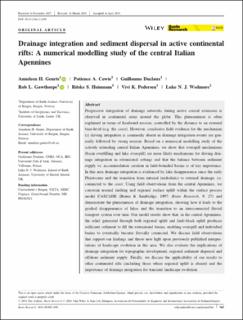| dc.contributor.author | Cowie, Patience | |
| dc.contributor.author | Duclaux, Guillaume | |
| dc.contributor.author | Gawthorpe, Rob | |
| dc.contributor.author | Huismans, Ritske | |
| dc.contributor.author | Pedersen, Vivi | |
| dc.contributor.author | Wedmore, Luke | |
| dc.contributor.author | Geurts, Anneleen H. | |
| dc.date.accessioned | 2021-03-15T09:36:27Z | |
| dc.date.available | 2021-03-15T09:36:27Z | |
| dc.date.created | 2018-11-05T20:34:32Z | |
| dc.date.issued | 2018 | |
| dc.Published | Basin Research. 2018, 30 (5), 965-989. | |
| dc.identifier.issn | 0950-091X | |
| dc.identifier.uri | https://hdl.handle.net/11250/2733328 | |
| dc.description.abstract | Progressive integration of drainage networks during active crustal extension is observed in continental areas around the globe. This phenomenon is often explained in terms of headward erosion, controlled by the distance to an external base‐level (e.g. the coast). However, conclusive field evidence for the mechanism(s) driving integration is commonly absent as drainage integration events are generally followed by strong erosion. Based on a numerical modelling study of the actively extending central Italian Apennines, we show that overspill mechanisms (basin overfilling and lake overspill) are more likely mechanisms for driving drainage integration in extensional settings and that the balance between sediment supply vs. accommodation creation in fault‐bounded basins is of key importance. In this area drainage integration is evidenced by lake disappearance since the early Pleistocene and the transition from internal (endorheic) to external drainage, i.e. connected to the coast. Using field observations from the central Apennines, we constrain normal faulting and regional surface uplift within the surface process model CASCADE (Braun & Sambridge, 1997, Basin Research, 9, 27) and demonstrate the phenomenon of drainage integration, showing how it leads to the gradual disappearance of lakes and the transition to an interconnected fluvial transport system over time. Our model results show that, in the central Apennines, the relief generated through both regional uplift and fault‐block uplift produces sufficient sediment to fill the extensional basins, enabling overspill and individual basins to eventually become fluvially connected. We discuss field observations that support our findings and throw new light upon previously published interpretations of landscape evolution in this area. We also evaluate the implications of drainage integration for topographic development, regional sediment dispersal and offshore sediment supply. Finally, we discuss the applicability of our results to other continental rifts (including those where regional uplift is absent) and the importance of drainage integration for transient landscape evolution. | en_US |
| dc.language.iso | eng | en_US |
| dc.publisher | Wiley | en_US |
| dc.rights | Navngivelse 4.0 Internasjonal | * |
| dc.rights.uri | http://creativecommons.org/licenses/by/4.0/deed.no | * |
| dc.title | Drainage integration and sediment dispersal in active continental rifts: A numerical modelling study of the central Italian Apennines | en_US |
| dc.type | Journal article | en_US |
| dc.type | Peer reviewed | en_US |
| dc.description.version | publishedVersion | en_US |
| dc.rights.holder | Copyright 2018 The Authors. | en_US |
| cristin.ispublished | true | |
| cristin.fulltext | original | |
| cristin.qualitycode | 2 | |
| dc.identifier.doi | 10.1111/bre.12289 | |
| dc.identifier.cristin | 1627249 | |
| dc.source.journal | Basin Research | en_US |
| dc.source.40 | 30 | |
| dc.source.14 | 5 | |
| dc.source.pagenumber | 965-989 | en_US |
| dc.identifier.citation | Basin Research. 2018, 30 (5), 965-989. | en_US |
| dc.source.volume | 30 | en_US |
| dc.source.issue | 5 | en_US |

